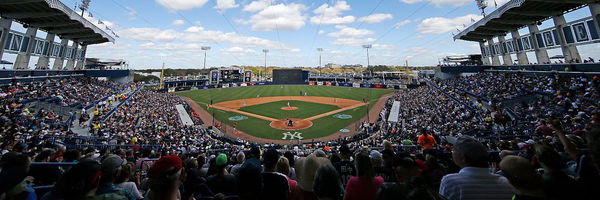

Hurricane Milton forced the Tampa Bay Rays to relocate to George M. Steinbrenner Field for the 2025 season – could this turn out to be the best thing to happen to the franchise in years? Temporarily playing in a Yankees-branded spring training park, it took a $50 million renovation to get the facility MLB-ready. But look past the logistical headaches and this could finally prove what many have argued for decades: The Rays belong in Tampa, not St. Petersburg.
For years, Rays fans have complained about the inconvenient location of Tropicana Field in St. Petersburg, where traffic across the Howard Frankland Bridge has kept thousands away from the ballpark. Now, with games being played in Tampa’s Westshore District, the franchise has a rare opportunity to test a long-theorized scenario: What if the team played in the heart of its fan base?
If attendance spikes in 2025, it could force the Rays and city officials to rethink their long-term stadium plans—regardless of their current commitment to a new ballpark in St. Pete.
ADVERTISEMENT
Article continues below this ad
Apple TV’s reporter Tricia Whitaker didn’t hold back when discussing the move on Foul Territory. She said, “People don’t come to St. Pete for games. That hasn’t changed since 1998. This stadium should be in Tampa, not St. Pete.”
Whitaker also pointed out that while Florida’s summer storms will pose a challenge for an open-air venue like Steinbrenner Field, the location itself is what really matters. “It’s going to give a lot of Rays fans in Tampa a chance to go to the game. I think it’s actually going to be good for them.”
The Rays playing in George Steinbrenner Field in 2025 could be a game-changer for the organization, says @TriciaWhitaker. pic.twitter.com/UI9wHQE9vY
— Foul Territory (@FoulTerritoryTV) February 21, 2025
Well, afternoon thunderstorms are practically a Florida tradition, and nobody likes a rain delay. But this season isn’t about perfection—it’s about proving a point. If attendance surges, it could reignite the debate over whether the Rays should have ever committed to rebuilding in St. Pete in the first place.
Make no mistake—this isn’t a long-term solution. The Rays remain committed to their new 1.3 billion St. Petersburg stadium, despite lingering funding questions and public skepticism. But if this season in Tampa goes well, the conversation might shift.
What’s your perspective on:
Could the Rays' move to Tampa finally prove St. Pete was the wrong choice all along?
Have an interesting take?
Will fans demand a permanent home on their side of the bridge? Will the Rays reconsider their future?
Challenges of the Rays playing at Steinbrenner Field
While Steinbrenner Field provides a new beginning for the Rays in Tampa; it comes with various logistical and operational hurdles.
The primary challenge arises from Florida’s summer climate which includes thunderstorms and high humidity paired with scorchingly hot temperatures. This combination creates tough conditions for gameplay in an outdoor stadium without a roof. Although the team can make schedule adjustments and implement cooling solutions to mitigate these challenges, the potential for weather-related delays and fan discomfort, during extended games, persists as concerns.
ADVERTISEMENT
Article continues below this ad
Apart from that, Steinbrenner Field has size issues, in comparison to full-time MLB stadiums.
It also lacks essential infrastructure amenities for players and fans alike due to its smaller seating capacity of just 11,026 spectators. A far cry from the 25,000-plus fans accommodated at Tropicana Field, making it the smallest temporary home for an MLB team since the Montreal Expos stint in Puerto Rico in 2003.
What else? The measurements of the baseball field – 318 feet down the lines and 385 feet to the center – benefit batters more as compared to the spaces in Tropicana Field. This contrast might impact how teams play on the field.
ADVERTISEMENT
Article continues below this ad
Steinbrenner Field might not be the perfect choice; however, it provides the Rays with a chance to assess their impact in the Tampa Bay area. What do you think? Can these drawbacks overshadow the advantages?
ADVERTISEMENT
ADVERTISEMENT
ADVERTISEMENT
ADVERTISEMENT


Could the Rays' move to Tampa finally prove St. Pete was the wrong choice all along?